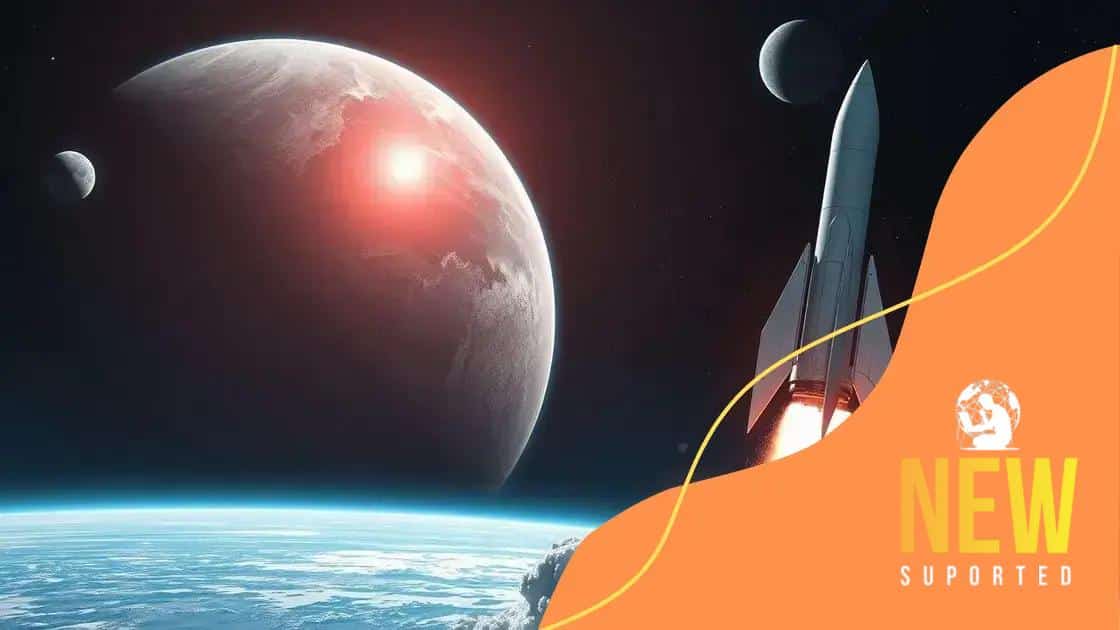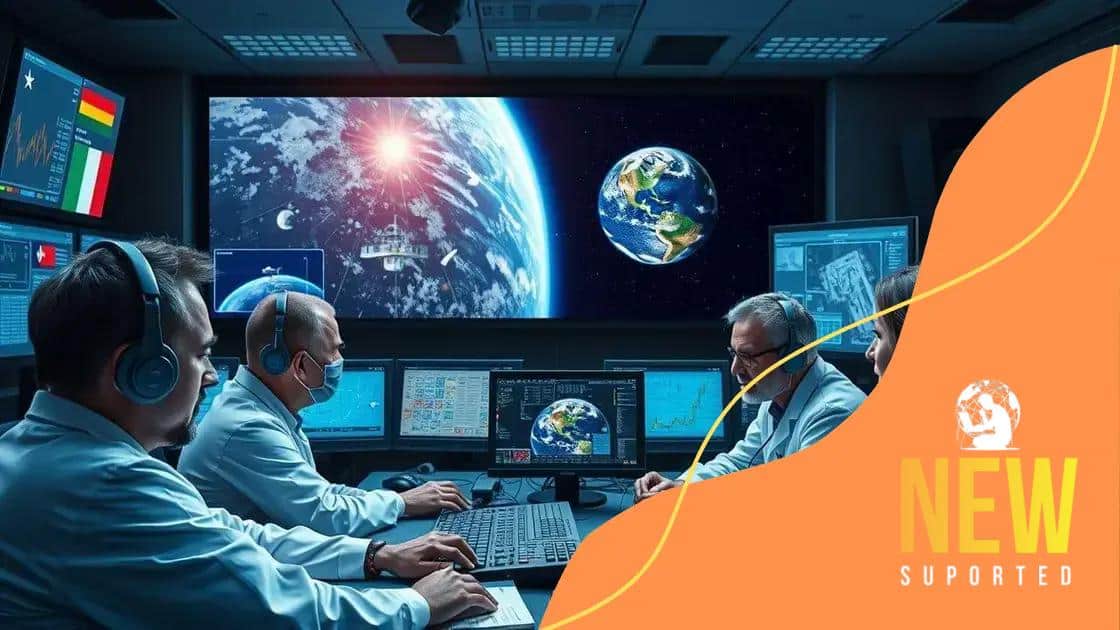Space exploration developments in the next decade

The future of space tourism is rapidly evolving, with companies like SpaceX and Blue Origin paving the way for civilian travel beyond Earth, offering suborbital and orbital flights that present both exciting opportunities and significant challenges.
Space exploration developments in the next decade are set to transform our relationship with the cosmos. Imagine the possibility of human life on Mars or breakthroughs in understanding distant galaxies. How do these advancements impact our lives today?
Key missions planned for the next decade
In the next decade, significant missions are set to launch, aiming to expand our understanding of the universe. These missions will not only enhance our knowledge but also push the boundaries of technology.
Upcoming lunar missions
One of the standout focuses will be on lunar exploration. NASA’s Artemis program aims to return humans to the Moon by 2024. The goal is to establish a sustainable presence on the Moon, enabling future crewed missions to Mars.
Exploring Mars
Alongside lunar efforts, missions to Mars are at the forefront. The Mars Sample Return mission is set to bring back samples from the Martian surface, providing valuable insights into the planet’s geology and its potential for past life.
International collaborations
Collaboration between countries will also play a crucial role. The European Space Agency (ESA) and other nations are teaming up to work on various projects that include Mars and Jupiter missions.
- Joint missions like ExoMars aim to explore Martian life.
- Jupiter’s moon, Europa, will be the target of several missions looking for signs of habitability.
- Increased cooperation can lead to reduced costs and shared scientific goals.
The presence of international experts will promote diversity in ideas and methods, enhancing the overall effectiveness of these missions. Looking ahead, we see technologies evolving to support these ambitious trips. From advanced propulsion systems to improved life support, the future of space missions looks promising.
In addition, we might see the rise of private companies participating in space exploration. Companies like SpaceX and Blue Origin are paving the way for commercial missions, which can dramatically change how we approach exploration.
Innovative technologies shaping space exploration
Innovative technologies are revolutionizing space exploration, making ambitious missions more feasible than ever. From advanced robotics to AI-driven systems, these technologies enhance our ability to explore the cosmos.
Robotic advancements
Modern robots are designed for a variety of tasks in space. These machines can perform repairs, collect samples, and even assist astronauts. For instance, NASA’s Rover missions have shown how effective robotic exploration can be. Their ability to navigate harsh terrains expands our reach.
Artificial intelligence applications
Artificial Intelligence (AI) is another game changer. AI helps analyze data from space missions quickly and accurately. It manages spacecraft autonomy, allowing probes to make decisions without needing constant communication with Earth.
- AI is used to detect anomalies in spacecraft systems.
- It can identify potential landing sites on other planets.
- Machine learning techniques improve the efficiency of data interpretation.
Moreover, cutting-edge materials are changing spacecraft design. Lightweight, durable materials make it easier to launch and maintain missions. Advanced propulsion systems are also in development, such as electric propulsion. These systems promise to reduce travel time within our solar system.
Next, 3D printing is being explored for creating tools and parts in space. This technology allows astronauts to produce necessary items on-demand, minimizing the need for carrying extensive supplies. Innovations in life support systems ensure astronauts have everything needed for prolonged missions.
International collaboration in space missions

International collaboration in space missions is becoming increasingly vital as we seek to explore the cosmos. By working together, countries benefit from shared resources, knowledge, and expertise.
Joint missions and partnerships
One of the best examples of collaboration is the International Space Station (ISS). It serves as a laboratory where astronauts from various nations conduct experiments and foster goodwill. The ISS project demonstrates how countries can combine technologies to reach a common goal.
Collaborative projects on Mars
Additionally, missions targeting Mars rely heavily on international efforts. The ExoMars program, led by the European Space Agency (ESA) in cooperation with Roscosmos, aims to search for signs of past life on the Red Planet.
- NASA and ESA share data and resources to maximize scientific returns.
- International teamwork reduces the costs associated with space exploration.
- Diverse perspectives lead to creative and innovative solutions.
Furthermore, establishing a permanent presence on the Moon is another area where global partnerships are essential. Various countries, including the United States, Europe, and Japan, are collaborating on the Artemis program. This initiative intends to create a sustained lunar presence, paving the way for future exploration.
Military and security collaborations are also important in space. Nations are constantly monitoring space activities and ensuring safety. Working together helps address potential collision risks and threats, ensuring a safer environment in orbit.
Chances for human settlement on Mars
The chances for human settlement on Mars are growing with each technological advancement. Researchers and engineers are exploring ways to make life on the Red Planet a reality.
Habitat construction
One of the first challenges to overcome is habitat construction. Engineers are developing materials that can withstand Mars’ harsh conditions. These habitats must provide protection from radiation, extreme temperatures, and dust storms.
Life support systems
Effective life support systems are crucial for long-term survival. These systems must efficiently recycle air, water, and nutrients. Researchers are experimenting with growing plants in Martian soil to ensure a sustainable food source.
- Hydroponics and aeroponics are promising techniques for growing crops in space.
- Water extraction from Martian soil is an ongoing research project.
- Advanced recycling systems can minimize waste and conserve resources.
Additionally, transportation to Mars will become more efficient. Current missions aim to shorten the travel time with advanced propulsion technologies. Furthermore, regular shuttle services could establish a routine journey between Earth and Mars for supplies and personnel.
Psychological well-being is another important aspect of creating a permanent base. Astronauts will need mental support to cope with isolation and the challenges of living on another planet. Research into social dynamics and mental health is essential to find solutions.
International cooperation can enhance the chances of settling on Mars. Collaborative missions will pool resources and knowledge, which not only leads to advancements but also encourages a unified effort for humanity’s future.
The future of space tourism
The future of space tourism is bright and exciting. As technology advances, more people may soon have the chance to travel beyond our planet. Private companies are leading this charge, making space travel accessible to the public.
Commercial space travel opportunities
There are already companies working on commercial space flights. For example, SpaceX, Blue Origin, and Virgin Galactic are developing spacecraft designed for tourism. These companies aim to create unforgettable experiences for travelers who want to see Earth from space.
Suborbital and orbital flights
Space tourism offers different types of flights. Suborbital flights provide a brief experience in space, allowing passengers to feel weightlessness and see the curvature of the Earth. In contrast, orbital flights can last several days, giving travelers a chance to experience the beauty of our planet from a unique perspective.
- Suborbital flights can last around 10-15 minutes.
- Orbital missions may offer stays of a week or more aboard space stations.
- Each type requires careful planning and safety measures.
As the industry grows, we can expect more innovations. Advances in technology will likely reduce costs and increase safety. For example, reusable rockets are a significant step toward making space travel more affordable.
Moreover, space tourism will also encourage scientific research. Travelers may participate in experiments and help gather data in various fields, including biology and environmental science. This way, tourism can contribute to our understanding of life beyond our atmosphere.
However, the growth of space tourism also poses questions. Concerns about space debris and environmental impacts must be addressed. The industry must strike a balance between exploration and preserving our planet and space.
FAQ – Frequently Asked Questions About Space Tourism
What is space tourism?
Space tourism refers to commercial activities that allow civilians to travel to space for recreational purposes.
Which companies offer space tourism services?
Companies like SpaceX, Blue Origin, and Virgin Galactic are leading the way in providing space tourism experiences.
How long do space tourism flights typically last?
Suborbital flights usually last about 10-15 minutes, while orbital missions can last several days.
What challenges does space tourism face?
Challenges include high costs, safety concerns, and environmental impacts related to space debris.






